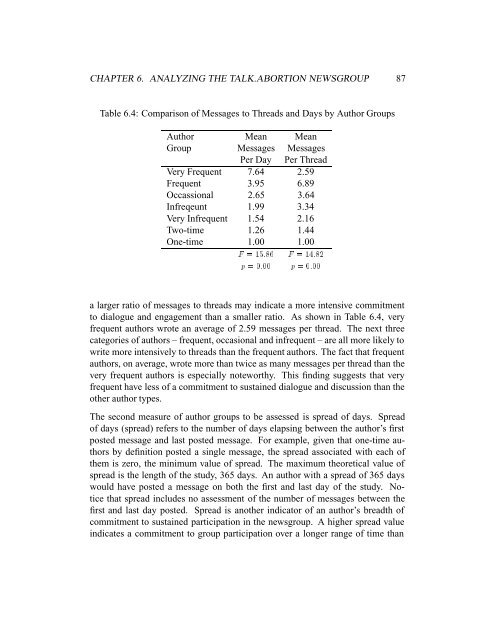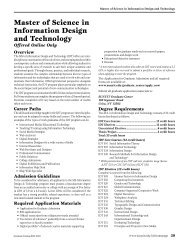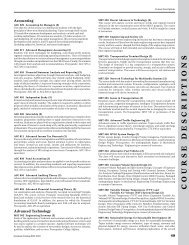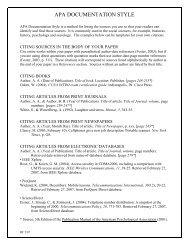Expanding the Public Sphere through Computer ... - ResearchGate
Expanding the Public Sphere through Computer ... - ResearchGate
Expanding the Public Sphere through Computer ... - ResearchGate
Create successful ePaper yourself
Turn your PDF publications into a flip-book with our unique Google optimized e-Paper software.
CHAPTER 6. ANALYZING THE TALK.ABORTION NEWSGROUP 87<br />
Table 6.4: Comparison of Messages to Threads and Days by Author Groups<br />
Author Mean Mean<br />
Group Messages Messages<br />
Per Day Per Thread<br />
Very Frequent 7.64 2.59<br />
Frequent 3.95 6.89<br />
Occassional 2.65 3.64<br />
Infreqeunt 1.99 3.34<br />
Very Infrequent 1.54 2.16<br />
Two-time 1.26 1.44<br />
One-time 1.00 1.00<br />
F =15:86 F =14:82<br />
p =0:00 p =0:00<br />
a larger ratio of messages to threads may indicate a more intensive commitment<br />
to dialogue and engagement than a smaller ratio. As shown in Table 6.4, very<br />
frequent authors wrote an average of 2.59 messages per thread. The next three<br />
categories of authors – frequent, occasional and infrequent – are all more likely to<br />
write more intensively to threads than <strong>the</strong> frequent authors. The fact that frequent<br />
authors, on average, wrote more than twice as many messages per thread than <strong>the</strong><br />
very frequent authors is especially noteworthy. This finding suggests that very<br />
frequent have less of a commitment to sustained dialogue and discussion than <strong>the</strong><br />
o<strong>the</strong>r author types.<br />
The second measure of author groups to be assessed is spread of days. Spread<br />
of days (spread) refers to <strong>the</strong> number of days elapsing between <strong>the</strong> author’s first<br />
posted message and last posted message. For example, given that one-time authors<br />
by definition posted a single message, <strong>the</strong> spread associated with each of<br />
<strong>the</strong>m is zero, <strong>the</strong> minimum value of spread. The maximum <strong>the</strong>oretical value of<br />
spread is <strong>the</strong> length of <strong>the</strong> study, 365 days. An author with a spread of 365 days<br />
would have posted a message on both <strong>the</strong> first and last day of <strong>the</strong> study. Notice<br />
that spread includes no assessment of <strong>the</strong> number of messages between <strong>the</strong><br />
first and last day posted. Spread is ano<strong>the</strong>r indicator of an author’s breadth of<br />
commitment to sustained participation in <strong>the</strong> newsgroup. A higher spread value<br />
indicates a commitment to group participation over a longer range of time than
















